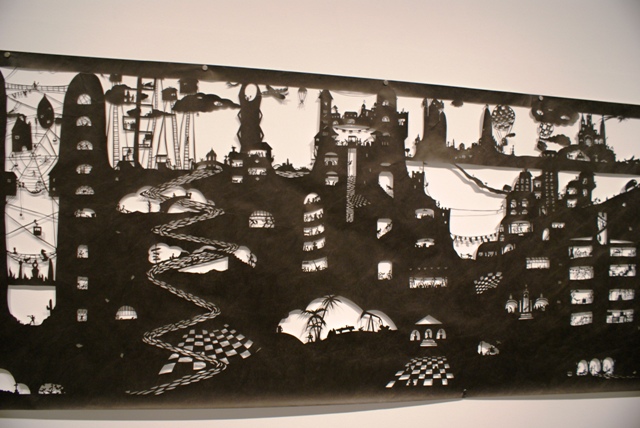
Who knew that cutting up paper could be so artistic? Yet paper cuts as an art form has been around for hundreds of years, according to Reni Gower, a professor of art at Virginia Commonwealth University and the curator of an exhibit currently at the Eleanor D. Wilson Museum through September 14. The Wilson Museum, located on the Hollins University campus, features works by Gower herself.
Also on display in three Wilson Museum galleries are works by Australian born Jaq Belcher, French artist Beatrice Colon, Michelle Forsyth, Czech-born Lenka Konopasek, southerner Lauren Scanlon and Californian Daniella Woolf. All show a different side of using paper as an art medium.
“I’m delighted to see how it came together,” said Gower during a recent opening lecture and gallery tour. Normally a painter, Gower noted that many of the artists who try their hand at paper cutting came from or work primarily in other mediums. There are only women in the Papercuts show; Gower said, “it just wound up that way.”

One arresting piece depicts a tornado, as people are swept up in the funnel. Gower saw it at another exhibit and exclaimed, “I gotta have that.” She said the artist saw tornadoes – much in the news these days – as metaphors that “focus you on the environment and global warming.”
Another piece from Lauren Scanlon features pages ripped from one of those torrid romance novels favored by housewives decades ago. Gower joked that between that piece and others like the tornado, the entire show had an undercurrent that was a little bit violent, a little macabre and “little smutty.” Viewers on opening night often stopped to read pages from the romance novel, giggling or shaking their heads at some of the overheated passages.
Daniella Woolf’s piece is quite different; dyed strips of wool that she sent to the museum unassembled, encouraging staffers there to put it together and hang it on the wall however they see fit. Coron’s 27-foot long diorama, carved into the sturdy Tyvek material also used in homebuilding, features all sorts of little vignettes.
“The Invisible City” as she calls it is based on a book. It has the feel of looking across an open space to an apartment building on the other side, as dramas play out in open windows, all in black silhouette. (Think Hitchcock’s “Rear Window” perhaps.) Gower called Colon “ a great punster.” Coron, who just became an artist at age 40, “feels strongly that everyone has a story to tell.” Her large installations can also be found in airports, subways and universities.
One of Jaq Belcher’s pieces, installed in part on the floor, makes Gower “think of a solar eclipse.” Forsyth, a Canadian by birth, used punch paper canvasses to tell tragic true stories from recent tragedies – floating bodies; a woman caught on a wire until her dress burns off. Another Forsyth work on display, which is mounted on the floor, is about the Exxon Valdez oil spill in Alaska several decades ago.
“It’s a very personal piece to her,” said Gower, noting that Forsyth spent many of her formative years on a sailboat. The first showing of the piece, which could suggest bubbles of oil on the water, was shown in Mobile, Alabama right after the nearby BP oil rig spill. “Very poignant,” notes Gower, who is curating the Papercuts show elsewhere as it tours and helping to stage variations of it as well. “People think I’m crazy,” she chuckles, “traveling with a paper show is kind of scary.”
By Gene Marrano


